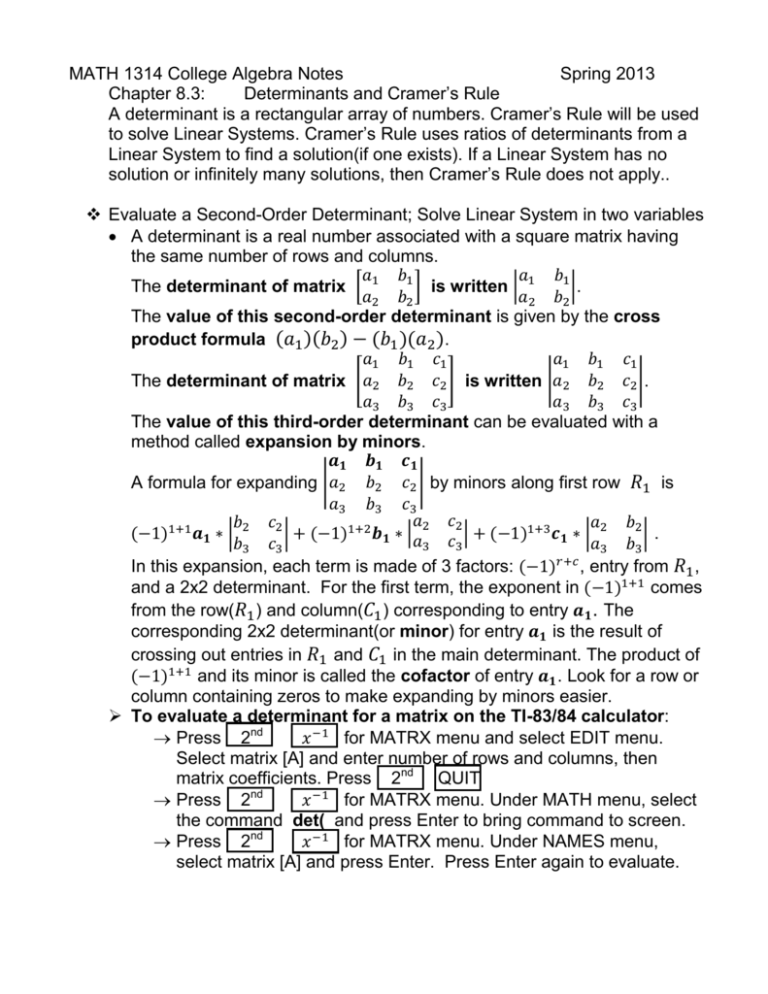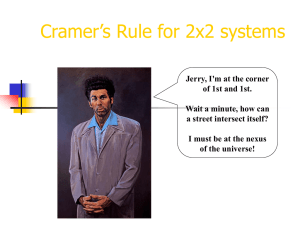MATH 1314 College Algebra Notes Spring 2013 Chapter 8.3
advertisement

MATH 1314 College Algebra Notes
Spring 2013
Chapter 8.3:
Determinants and Cramer’s Rule
A determinant is a rectangular array of numbers. Cramer’s Rule will be used
to solve Linear Systems. Cramer’s Rule uses ratios of determinants from a
Linear System to find a solution(if one exists). If a Linear System has no
solution or infinitely many solutions, then Cramer’s Rule does not apply..
Evaluate a Second-Order Determinant; Solve Linear System in two variables
A determinant is a real number associated with a square matrix having
the same number of rows and columns.
The determinant of matrix [
] is written |
|.
The value of this second-order determinant is given by the cross
product formula ( )( ) ( )( ).
The determinant of matrix [
] is written |
|.
The value of this third-order determinant can be evaluated with a
method called expansion by minors.
A formula for expanding |
(
)
|
|
(
| by minors along first row
)
|
|
(
)
|
is
|.
In this expansion, each term is made of 3 factors: ( ) , entry from ,
and a 2x2 determinant. For the first term, the exponent in ( )
comes
from the row( ) and column( ) corresponding to entry . The
corresponding 2x2 determinant(or minor) for entry
is the result of
crossing out entries in
and
in the main determinant. The product of
( )
and its minor is called the cofactor of entry . Look for a row or
column containing zeros to make expanding by minors easier.
To evaluate a determinant for a matrix on the TI-83/84 calculator:
Press 2nd
for MATRX menu and select EDIT menu.
Select matrix [A] and enter number of rows and columns, then
matrix coefficients. Press 2nd QUIT
Press 2nd
for MATRX menu. Under MATH menu, select
the command det( and press Enter to bring command to screen.
Press 2nd
for MATRX menu. Under NAMES menu,
select matrix [A] and press Enter. Press Enter again to evaluate.
MATH 1314 College Algebra Notes
Chapter 8.3:
Spring 2013
Determinants and Cramer’s Rule
To solve a Linear System in two variables using Cramer’s Rule will
require:
Forming and evaluating the determinants ,
, and
then finding solutions for and with the values of ,
, and
In general, for a Linear System in two variables{
the determinants are
|
and the solution is
and
|,
,
|,
|
, provided that
.
|
|
Important: Whenever determinant
, the Linear System cannot be
solved with Cramer’s Rule.
If
and
or
, then the Linear System is
__inconsistent__ and the system has __no solution__.
If
,
, and
, then the equations in the Linear System
are _dependent__ and the system has __infinitely many solutions__.
To solve a Linear System with determinants on the TI-83/84
calculator:
Press 2nd
for MATRX menu and select EDIT menu.
Select matrix [A] and enter number of rows and columns, then
coefficients for
. Press 2nd QUIT
Repeat with matrix [B] for
.
Repeat with matrix [C] for
and so on as needed.
nd
Press 2
for MATRX menu. Under MATH menu,
select determinant command det( . Press ENTER.
Press 2nd
for MATRX menu again. Under NAMES
menu, select matrix [A]. Press ENTER to bring matrix [A] to
screen. Press ENTER again to evaluate det( [A] ).
Repeat to evaluate det( [B] ) and det( [C] ) .
Solutions will be
,
, and so on, if they exist.
Cramer’s Rule
Practice problems
Step 1: Set up determinants
|
|,
,
|
,
Spring 2013
.
|,
|
|
Step 2: Use cross product formula for second-order determinants or TI-83/84 det(
command to evaluate each square determinant.
(If
, then the system either has infinitely many solutions or no solution,
therefore Cramer’s Rule is not applicable in determining a solution set.)
,
Step 3: Since
,
, Cramer’s Rule is not applicable in determining a solution set.
Select Answer Choice B.
Cramer’s Rule
Practice problems
Step 1: Set up determinants
|
|,
|
,
Spring 2013
,
,
.
|
|,
|
|,
|
Step 2: Use Expansion by Minors method for third-order determinants or TI-83/84
det( command to evaluate each square determinant.
(If
, then the system either has infinitely many solutions or no solution,
therefore Cramer’s Rule is not applicable in determining a solution set.)
,
Step 3: Since
,
,
is not zero, the system has solutions and are given by
,
,
Select Answer Choice A and enter solutions








